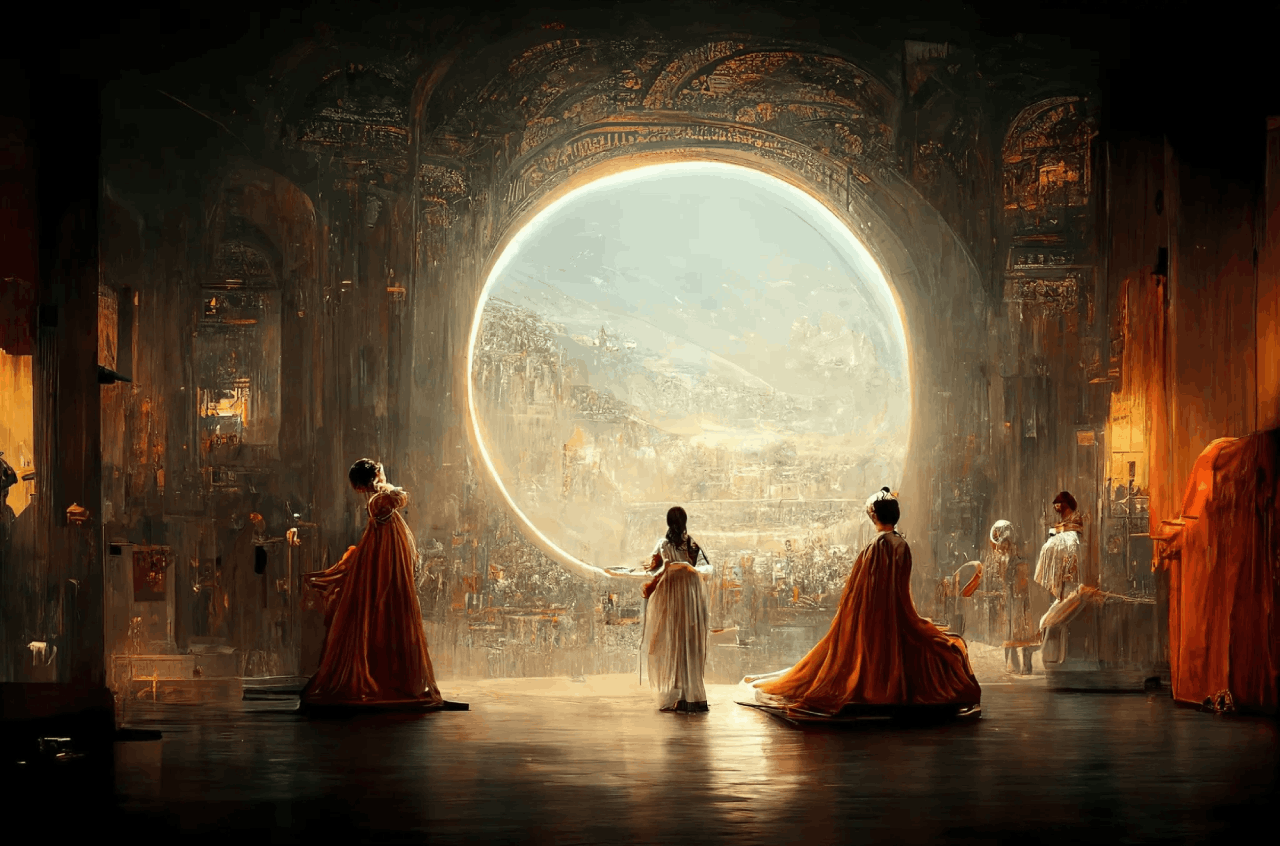Generative AI is rapidly transforming the technological landscape, offering exciting possibilities in both creative and analytical fields. This article delves into the world of Generative AI, exploring its fundamentals, role in technology, impact on creativity, and potential applications in analytical technologies. Additionally, ethical considerations surrounding Generative AI are examined, shedding light on the need for a balance between innovation and ethics and the role of regulation in AI development.
Understanding Generative AI
Generative AI is an area of artificial intelligence that focuses on the autonomous generation of content. Traditional AI is primarily used for analysis and optimization. Instead, Generative AI enables machines to produce original content.
The interest in GenAI sparkled in 2022 as we acquainted ourselves with ChatGPT. Now, the examples of GenAI vary. They include tools like Squibler, Simplified, or Neuroflash that can generate fiction books and are widely used by authors worldwide to assist in fiction development, OpenAI’s DALL-E which is able to generate images or their product Sora that makes videos from textual prompts.
One fascinating aspect of Generative AI is its ability to adapt and evolve through time. As these systems continue to learn from new data, they become even more sophisticated. This iterative process of learning and creation sets Generative AI apart from other forms of artificial intelligence.
The Basics of Generative AI
Generative AI utilizes techniques like deep learning and neural networks to generate new content that mimics human creativity. By training models on vast amounts of data, these systems learn patterns and generate new outputs based on the identified patterns. So, in essence, GenAI learns from examples and produces novel content in accordance with what it’s learned.
Furthermore, Generative AI can also be used to enhance human creativity by serving as a tool for inspiration and exploration. Artists, musicians, and writers can collaborate with Generative AI systems to generate new ideas, explore different styles, and push the boundaries of their creativity. This symbiotic relationship between humans and machines opens up exciting possibilities for innovation and artistic expression.
For example, a GenAI writing tool, Neuroflash, helps authors create character profiles, and write dialogues or entire chapters.
The Role of Generative AI in Technology
Generative AI has the potential to revolutionize various technological fields. For instance, in the realm of virtual reality, Generative AI can create realistic and immersive worlds by autonomously generating detailed textures and environments. In healthcare, Generative AI can assist in drug discovery by simulating and generating potential drug compounds. In finance, these systems can be used to generate trading strategies based on historical market data, allowing for more informed decision-making.
Interested in learning how GenAI stacks up against traditional AI models?
Check our article Balancing Algorithms and Data!
Moreover, Generative AI is also being explored in the field of natural language processing, where it can be used to generate human-like text and dialogue. This application of Generative AI opens up new possibilities for chatbots, virtual assistants, and content generation. By leveraging the power of language generation, companies can enhance customer interactions, streamline communication processes, and create personalized user experiences.
The Intersection of Creativity and Generative AI
The advent of Generative AI offers new tools and approaches for artistic and design processes. It prompts, automates and takes away the routines. Thus, GenAI cuts the lengthy way from an idea to a product.
How Generative AI is Transforming Creative Processes
As Generative AI continues to evolve, it is becoming increasingly integrated into various creative fields, from visual arts to music composition. Here are several use cases to illustrate how GenAI boosts creativity:
Use case 1: a writing tool Squibler helps writers generate scene descriptions. Usually, describing settings is rather a technical process than a creative one, but it is necessary for a novel’s authenticity. So, authors have to spend part of their time doing this routine job, instead of discovering new ways of scenario development.
Use case 2: two years ago, the Colorado “digitally manipulated photography” contest was won by John Allen and his artwork “Théâtre D’opéra Spatial.” John Allen created his prize-winning work with the help of Midjourney AI. Yet, the work wasn’t created by GenAI itself. The artist generated more than 900 versions of the art, spending 80 hours on experimenting with prompts. The outcome was then fine-tuned with Adobe Photoshop and other AI tools to increase its sharpness.

Jason Allen’s A.I.-generated work, “Théâtre D’opéra Spatial,” Sorce: The New York Times
Use case 3: Open AI’s Sora has recently generated an episode of the Minecraft game. It was a part of the joint research of a host of OpenAI researchers. As reported, Sora is able to do various image and video editing tasks, from creating looping videos to extending videos forwards or backwards in time. It can also change video backgrounds. In the experiment described, Sora was given different prompts to containing the word “Minecraft” and generated a convincingly Minecraft-like video.

Sora-generated Minecraft episode, Credit: OpenAI
As we see from examples, GenAI is not meant to replace human creativity, but rather to complement and enhance it. By leveraging the power of machine learning algorithms, artists and designers can explore uncharted territories and discover novel ways of expression.
The essence of creative collaboration between authors and GenAI
Artists and designers are now collaborating with Generative AI systems to explore new creative possibilities. Yet, humans still have to teach GenAI to interpret their artistic purposes.
The collaboration takes the form of human prompts and AI outputs. Yet, as the results are not always as good as expected and repetitive prompt sessions tend to be frustrating, services, facilitating the communication between the machine and the human, come to the stage. Harvard Business Review predicts that the “prompt engineer” is likely to become an established profession in the coming months. There already exist manuals like an 82-page book of DALL-E 2 with a collection of prompts that yield acceptable results.
Yet, as a set of properly working parameters and guidelines is selected, artists can unleash the machine’s creativity to generate a myriad of unique ideas. This creative collaboration expands the boundaries of what is possible and encourages innovation.
The Impact of AI on Art, Music, and Design
The impact of Generative AI on art, music, and design is huge. It has the potential to transform the whole creative niche. According to Gartner’s prediction, GenAI-generated content will make 10% of all the generated data by 2025.
AI systems can compose original music pieces, generate intricate works of art, and develop innovative designs. These will not just give a boost to the amount and speed of content generation but will also stimulate new artistic trends.
Furthermore, integrating Generative AI in the creative process has led to a redefinition of authorship and creativity and requires a step-in on behalf of law. Since GenAI training requires tons of data (GPT-3, for example, was trained on 45 terabytes of data, usually taken from the web), the authors of data used for training claim royalty. For example, the media outlets Raw Story, Alternet, and The Intercept have recently sued Sam Altman for copyright infringement.
Also, the lines between human and machine-generated art are becoming increasingly blurred, raising questions about the nature of creativity and the role of the artist in the age of AI. As Jason M. Allen won the digital art contest in 2022, the set off a strong backlash from other artists, accusing him of cheating. There surely exists a need for a demarcation line for the understanding of different concepts of art.
Generative AI in Analytical Technologies
Beyond creativity, Generative AI is also proving to become a game-changer in analytical technologies, enhancing data analysis and predictive modeling. For example, according to McKinsey report, Gen AI will add the equivalent of $2.6 trillion to $4.4 trillion annually in value across industries. In the banking area, where the predictive and model-building capabilities of GenAI are used most often, GenAI can generate an annual potential of $200 billion to $340 billion from increased productivity mostly.
Enhancing Data Analysis with Generative AI
Generative AI can analyze vast amounts of data and generate insights and predictions. By identifying patterns, trends, and correlations, these AI systems can support decision-making processes and uncover hidden insights that may have otherwise gone unnoticed. This capability revolutionizes data analysis, enabling faster and more accurate decision-making.
Moreover, Generative AI excels in handling unstructured data, such as text and images, allowing organizations to extract valuable information from diverse sources. This versatility makes Generative AI a powerful tool for businesses looking to gain a competitive edge through advanced data analysis techniques.
Predictive Modeling and AI
With Generative AI, predictive modeling becomes even more powerful. These systems can generate multiple potential outcomes based on historical data, providing valuable insights into future scenarios. This assists businesses in making informed decisions and adapting to changing market conditions.
Furthermore, Generative AI can enhance the accuracy of predictive models by incorporating real-time data streams and adjusting predictions in response to dynamic changes. This adaptability ensures that organizations can stay ahead of the curve and make proactive decisions based on the most up-to-date information available.
The Future of Generative AI
As Generative AI continues to evolve, exciting trends and challenges lie ahead.
Emerging Trends in Generative AI
One of the emerging trends to discuss is the combination of Generative AI with other technologies, such as reinforcement learning or natural language processing. These integrations push the boundaries of what Generative AI can achieve, opening up even more possibilities in various domains.
Another notable trend in Generative AI is the rise of unsupervised learning approaches, where algorithms learn from unlabelled data. This shift towards self-learning models not only enhances the autonomy of Generative AI systems but also improves their adaptability to diverse datasets and scenarios.
Potential Challenges and Solutions for Generative AI
Despite its potential, Generative AI also faces challenges. These include biases in training data and the ethical implications of AI-generated content. For example, recently the tech community was stirred with a dispute between X’s owner Elon Musk and Google over Google’s Gemini AI. The tech billionaire accused Google’s Gemini of being biased and racist. The reson was an output Gemini gave to the question whether the US former president Barack Obama and Elon Musk could be compared to the Nazi’s Hitler. While the algorithm thought Barack Obama cannot be compared to the German dictator by any means, with Elon Musk, the answer was “it’s complicated” which offended the billionaire.
So, it is clear that to address these challenges, ongoing research and collaboration between industry leaders, policymakers, and ethicists are essential. By continually iterating and refining Generative AI, the field can achieve responsible and beneficial outcomes. Also, having more people engaged in training GenAI on their data sets will bring about more balanced and weighed approaches in AI’s rationing.
So, if you have a vision of your own AI product but little knowledge of how to implement it in real life, you are lucky!
eNest offers a limited opportunity to book a free consultation with an industry specialist to discuss your project. You will have a detailed explanation of the technologies to be used, a number and seniority level of experts to be involved, and also a clear outline of the project’s cost and duration. Start discussing your own GenAI tool now. Book a call!
Furthermore, the scalability and computational requirements of advanced Generative AI models pose significant challenges for widespread adoption. Researchers are actively exploring methods to optimize model efficiency and reduce resource-intensive training processes, making Generative AI more accessible and cost-effective for businesses and individuals alike.
Ethical Considerations in Generative AI
As Generative AI becomes more prevalent, it is crucial to consider the ethical implications surrounding its development and usage.
One of the key ethical considerations in Generative AI is the potential for bias in AI systems. Biases can be inadvertently introduced during the training data selection process or through the algorithms themselves, leading to discriminatory outcomes. Addressing bias in AI requires a concerted effort to diversify datasets, implement fairness metrics, and continuously monitor and evaluate AI systems for any biases that may arise.
Balancing Innovation and Ethics in AI
While Generative AI opens up exciting opportunities, it is essential to ensure that its development and deployment prioritize ethical considerations. Developers and researchers must take responsibility for designing AI systems that align with societal values and do not harm individuals or communities.
Another ethical consideration is the transparency and accountability of AI systems. As AI technologies become more complex and autonomous, ensuring transparency in how decisions are made and holding AI systems accountable for their actions is crucial. Establishing clear guidelines for AI explainability and creating mechanisms for recourse in the event of AI errors or misuse are essential steps in upholding ethical standards in Generative AI.
The Role of Regulation in AI Development
Regulation plays a crucial role in shaping the development and use of Generative AI. Establishing guidelines and standards ensures the responsible use of AI, protects individuals’ privacy and rights, and addresses potential biases or discriminatory practices. Ongoing dialogue between policymakers, AI experts, and the public is essential to balance innovation and ethical concerns.
Summing up
As we continue exploring the vast potential of Generative AI, it is clear that this technology is driving significant transformations in both creative and analytical fields. By understanding its fundamental principles, embracing its potential, and addressing its ethical implications, we can unlock a future where Generative AI amplifies human creativity and augments our analytical capabilities.
Looking for help building a GenAI solution to drive people and money to your business?
Call eNest for a free consultation and advice! Our team offers the exclusive possibility of discussing your idea with a tech specialist at a zero-hourly rate. In the talk, you will get answers to questions like if the idea is viable, how much it will cost, and how soon it can go to the market. Don’t lose your chance for expert advice. Book your free call now!
Have a question?
Speak to Data Scientist
 Jagdeep Chawla
Jagdeep ChawlaMS in Data Science
NorthWestern Univeristy, Illinois
MS in Data Science
NorthWestern Univeristy, Illinois




